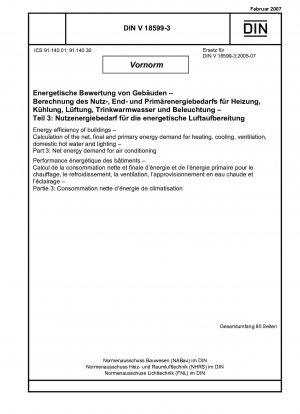DIN V 18599-3:2007
Energy efficiency of buildings - Calculation of the net, final and primary energy demand for heating, cooling, ventilation, domestic hot water and lighting - Part 3: Net energy demand for air conditioning
- Standard No.
- DIN V 18599-3:2007
- Release Date
- 2007
- Published By
- German Institute for Standardization
- Status
- Replace By
- DIN V 18599-3:2011
- Latest
- DIN V 18599-3:2018-09
- Scope
- The DIN V 18599 series of prestandards provides a methodology for calculating the overall energy balance of buildings. The described algorithm is applicable to the calculation of energy balances for: -- residential buildings and non-residential buildings; -- planned or new building construction and existing buildings. The procedure for calculating the balances is suitable for: -- balancing the energy use of buildings with partially pre-determined boundary conditions; balancing the energy use of buildings with freely-selectable boundary conditions from the general engineering aspect, e.g. with the objective of achieving a good comparison between calculated and measured energy ratings. The balance calculations take into account the energy use for: -- heating, -- ventilation, -- air conditioning (including cooling and humidification), -- heating the domestic hot water supply, and --lighting of buildings, including the additional electric power input (auxiliary energy) which is directly related to the energy supply. The method described in this document can be used to determine the energy need for thermal air conditioning (useful, or "net", energy) as well as the delivered energy (i.e. energy use) for air transport in ventilation and air conditioning systems (VAC systems) which partly use external air. The energy need is the monthly total of energy required by the heating, cooling, humidification and dehumidification functions to condition external air in order to achieve the desired supply air properties. The electrical energy demand of air transport includes the energy required by the fan and the mechanical transmission systems and the energy required to generate the mechanical energy needed. This document does not include ventilation systems and air heating systems for residential buildings. These systems are dealt with in DIN V 18599-6. The energy need for thermal air conditioning can only be calculated if the basic thermodynamic process controls involved are known. The process controls are determined by the order of the components in the VAC systems and by the basic rules according to which the system is operated. Ideal process control modes are assumed in the calculations to determine the energy need. For calculation of the delivered energy for air transport, the air system pressure losses shall first be determined or a maximum value of the air system pressure losses shall first be specified. In order to determine the delivered thermal energy, the deviations of the actual application from the ideal process control assumptions, expressed in terms of energy expended, shall be added to the calculated energy need. This procedure is defined in DIN V 18599-7.
DIN V 18599-3:2007 history
- 2018 DIN V 18599-3:2018-09 Energy efficiency of buildings - Calculation of the net, final and primary energy demand for heating, cooling, ventilation, domestic hot water and lighting - Part 3: Net energy demand for air conditioning
- 2018 DIN V 18599-3:2018 Energy efficiency of buildings - Calculation of the net, final and primary energy demand for heating, cooling, ventilation, domestic hot water and lighting - Part 3: Net energy demand for air conditioning
- 2016 DIN V 18599-3:2016 Energy efficiency of buildings - Calculation of the net, final and primary energy demand for heating, cooling, ventilation, domestic hot water and lighting - Part 3: Net energy demand for air conditioning
- 2011 DIN V 18599-3:2011 Energy efficiency of buildings - Calculation of the net, final and primary energy demand for heating, cooling, ventilation, domestic hot water and lighting - Part 3: Net energy demand for air conditioning
- 2007 DIN V 18599-3:2007 Energy efficiency of buildings - Calculation of the net, final and primary energy demand for heating, cooling, ventilation, domestic hot water and lighting - Part 3: Net energy demand for air conditioning
- 2005 DIN V 18599-3:2005 Energy efficiency of buildings - Calculation of the net, final and primary energy demand for heating, cooling, ventilation, domestic hot water and lighting - Part 3: Net energy demand for air conditioning
